Studio Visit
Los Angeles Artist Sayre Gomez On the Pull of the City’s Forgotten Corners
The artist's solo show "Heaven N' Earth" is currently on view at Xavier Hufkens in Brussels.
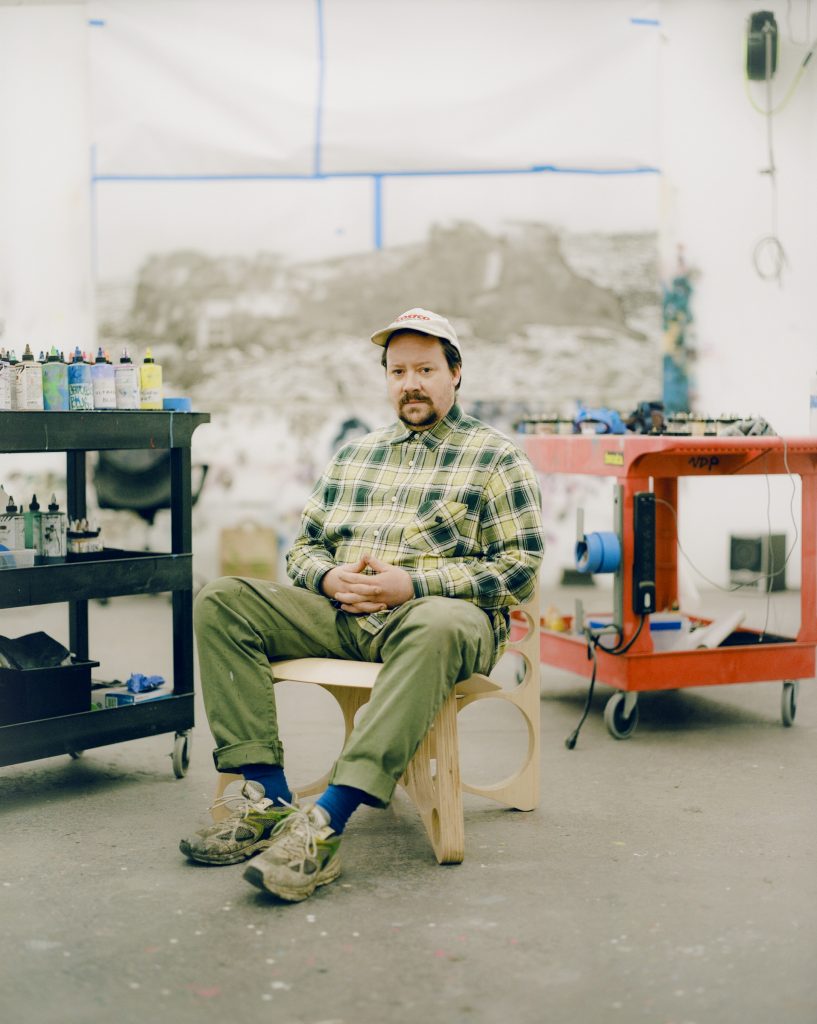
Artist Sayre Gomez knows that Los Angeles is a tale of two cities. The discomfiting disparities between its worlds come to the fore in his hyperrealist paintings.
This week, as the art world flocks to the Santa Monica pier for Frieze LA, two of Gomez’s paintings will go on view in “Desire, Knowledge, and Hope (With Smog)” an exhibition of Los Angeles artists at the Broad. The paintings— Diamonds and Pearls (2022) and The Whole Wide World is a Haunted House (2022)—respectively depict a nail salon storefront, a neon “open” sign glowing red, and a dilapidated building, seemingly awaiting demolition—immortalizing a side to the city that museum visitors might otherwise never really notice.
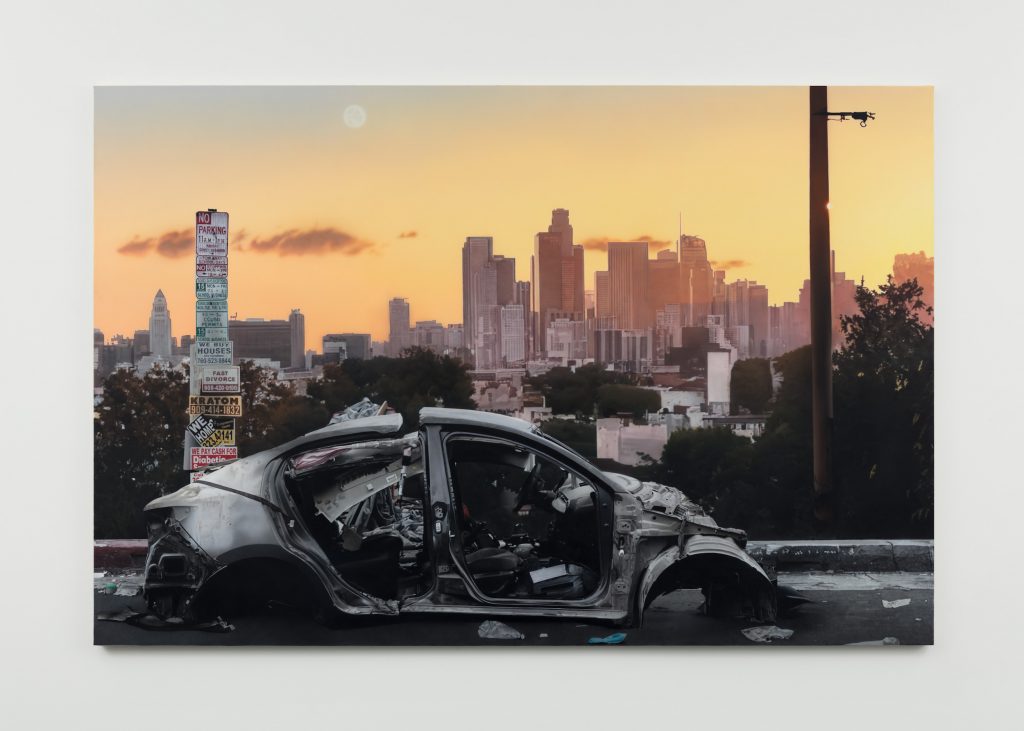
Sayre Gomez, We Pay Cash (2023). Courtesy of the artist and Xavier Hufkens.
Los Angeles’s distinctive visual landscape is at the heart of Gomez’s work—its car culture, psychedelic sunsets, urban decay, and gritty glamour can all be found in his lexicon. Born in Chicago, the artist has called L.A. home for nearly two decades, and he has witnessed the challenges and changes of the city, often firsthand, on drives to and from his Boyle Heights studio.
Right now, a series of Gomez’s most recent works—dozens of new paintings and several sculptures—are on view in “Heaven ‘N’ Earth” at Xavier Hufkens in Brussels (through March 2, 2024). The exhibition crosses the gallery’s four floors and charts a kind of heaven (top floor) to earth (and beyond) journey through Los Angeles’s late capitalist realities and the people and remnants in its wake. Gomez, meanwhile, doesn’t deny the ways these very realities become cultural signifiers in what the gallery calls “the hyperreality of technologized spectacle.”
Recently, we caught up with Gomez and talked about the changing face of the city he calls home and how driving is an essential part of his practice.
“Heaven N’ Earth” is an expansive show that takes viewers through Los Angeles but also, physically, through a four-story gallery. Can you tell us a bit about how the gallery space informed the installation of your work?
The gallery is a four-story mini museum in a way. The space is huge and filling it has been quite an undertaking. I made the works in the show over the past year and a half—this is what I’ve been putting all my energy into for months.
My work, and what it’s interested in, follows a through-line from one show to the next—it’s all pretty interrelated and this is no exception. But as I planned this exhibition, I did respond to the massiveness of the space and its unusual specificities. The first floor consists of different little rooms while the room on the roof has this epic, huge skylight. On a lower floor, another room has lower ceilings and skylights along only one side. Another room has a wooden floor with a more intimate, domestic feeling. Meanwhile, the basement floor has one wall that is all glass.
The concept of heaven and earth emerged from these transitions in space. I had ten iterations of the exhibition design before we landed on the final one.
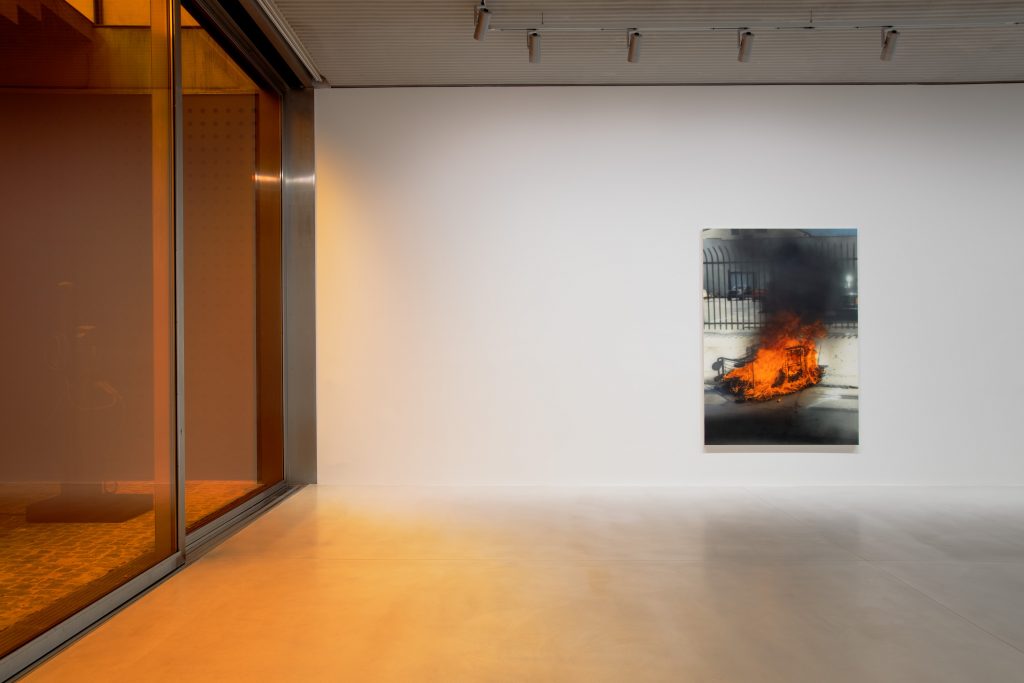
Installation view “Sayre Gomez: Heaven N’ Earth” 2024. Courtesy of the artist and Xavier Hufkens.
Tell us about your studio. How long have you been there and how would you describe it?
Oh man, I love my studio. I moved in in 2008 so that’s 16 years ago. It’s in Boyle Heights in Los Angeles. For a while, I was getting depressed about the studio. I’d been in it for so long, but I didn’t own the building and I couldn’t get the landlord to fix anything. Then in 2020, I finally convinced the landlord to sell it to me—I’d been in the studio forever and I occupied all three available properties. It was one building split into three rentable units and I rented all of them. My landlord was quite seriously something like 103 years old at the time. He’s still alive and probably one of the oldest people living. Since I bought the building, I’ve been slowly fixing the space up. But that’s the other tricky thing about a studio—I have to make improvements in sections because I need to be working all the time.
Then, in 2022, I bought a smaller space that is half a block away. This “second studio” is my quiet space—I have a little kitchen and a couch and can make coffee and sit down. In my main studio, I have a team that works with me in versatile ways—painting, doing preproduction, working on Maya, making 3-D drawings—there’s so much going on, and it’s very fun but it can also be hard to concentrate. This smaller space is a little more focused. I can play my own music and think.
I know many of your paintings are based on scenes you’ve seen in your own life. What draws you to a particular image? How do you decide what you’ll paint or sculpt?
Everything starts with a kernel of an idea that happens observationally, almost exclusively from a commute. Commuting—driving—has been impactful to my work, which I think is relatable. Driving is something most people do. I’ll usually take some photographs—those photographs will linger on my phone for a while. Then I start thinking about constructing an image. Sometimes an image is so good that I don’t even touch it and I’ll make a painting of it as is. Other times, maybe I’ll have a photograph or strip mall and I realize the door alone would be good as a standalone painting. I’ll zero in on one little kind of architectural component. I think of my work as one overarching look at our environment.
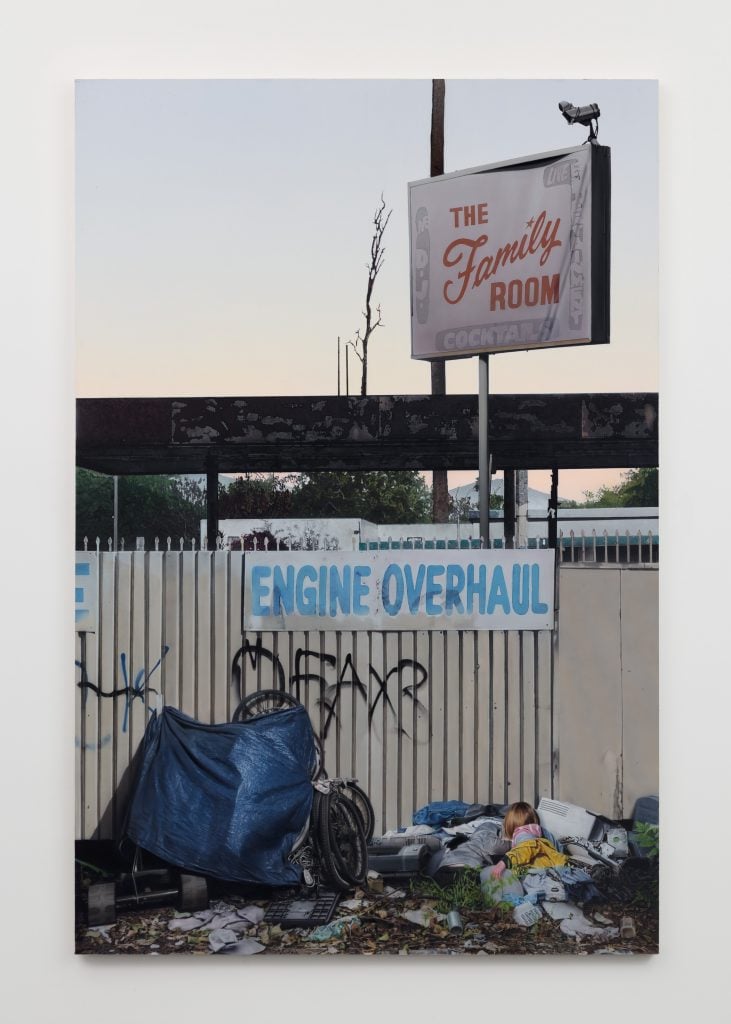
Sayre Gomez, Family Room (2023). Courtesy of the artist and Xavier Hufkens.
Your process is quite specific and labor-intensive. Can you describe it to us?
Yes, so working from my photographs, I’ll often composite images and alter them in Photoshop or Maya—3D rendering is great for adding reflections and other aspects that are hard to fake in Photoshop. My team and I will come up with whatever our desired imagery is, then we’ll make a technical drawing of it in Adobe Illustrator. Based on the technical drawing, we have that cut in an adhesive vinyl.
If there’s a sky or if there’s something that’s kind of soft focus, we’ll paint that first using a projector. Then we’ll put a layer of vinyl over everything so the entire surface is covered with this technical drawing. We make an underpainting using that and remove the vinyl as we go. At that point, we’ll have a value–based underpainting.
Once we get to a point where we remove all the vinyl, we’ll start painting in all the colors in layers, in glazes. I’ll start softening up the edges since everything is very hard-edged at that point. When everything’s done and we’re happy, we put on a very matte surface varnish. Oh, and I should say, we use an airbrush for almost everything.
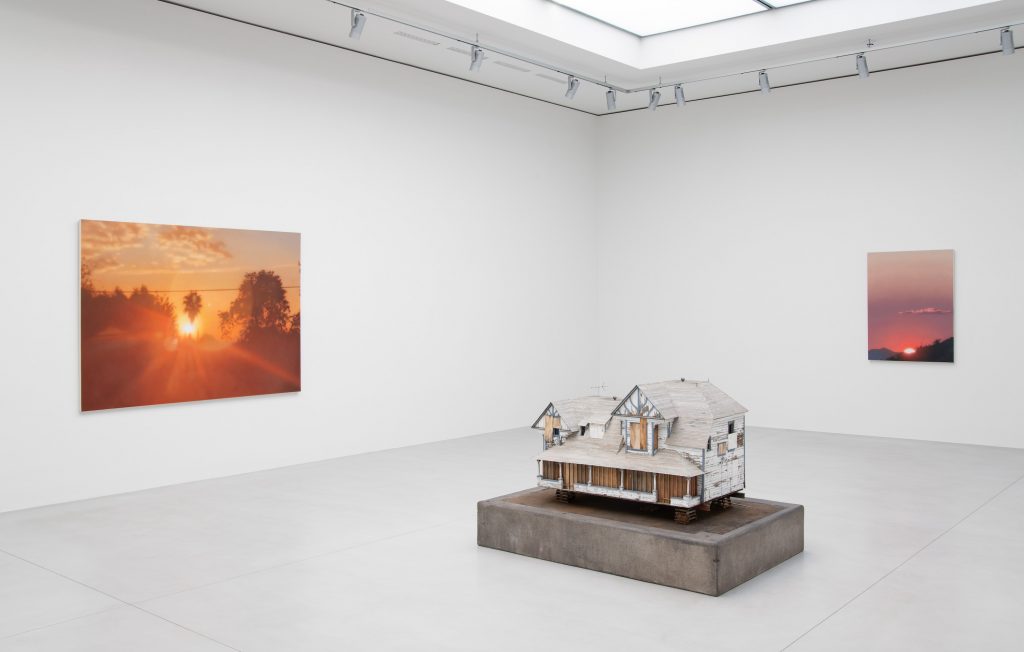
Installation view “Sayre Gomez: Heaven N’ Earth” 2024. Courtesy of the artist and Xavier Hufkens.
Is there one work in the show that holds a particular resonance for you?
There’s a maquette of a house in the show titled Scale Replica of the Past, Present, and Future (Peabody Werden House). It’s somewhere between a baroquely detailed dollhouse miniature and an architectural model. That’s based on something real and kind of a funny story.
When I just finished graduate school, I took a bunch of photos of houses I had seen in different neighborhoods, both where I was living at the time and around my studio. These were Victorian-era homes, from the turn of the last century that were being condemned. These houses were compelling to me, you know, here are these architecturally beautiful and significant structures that are condemned and you know will be destroyed. You know the houses are condemned because they’re actually raised off the ground—I come from Chicago, where houses have basements, so I’d never seen this before. But I saw it quite a lot when I moved here.
So, I took all these photographs of the houses, but I didn’t really know what I would do with them, and I never really worked with them.
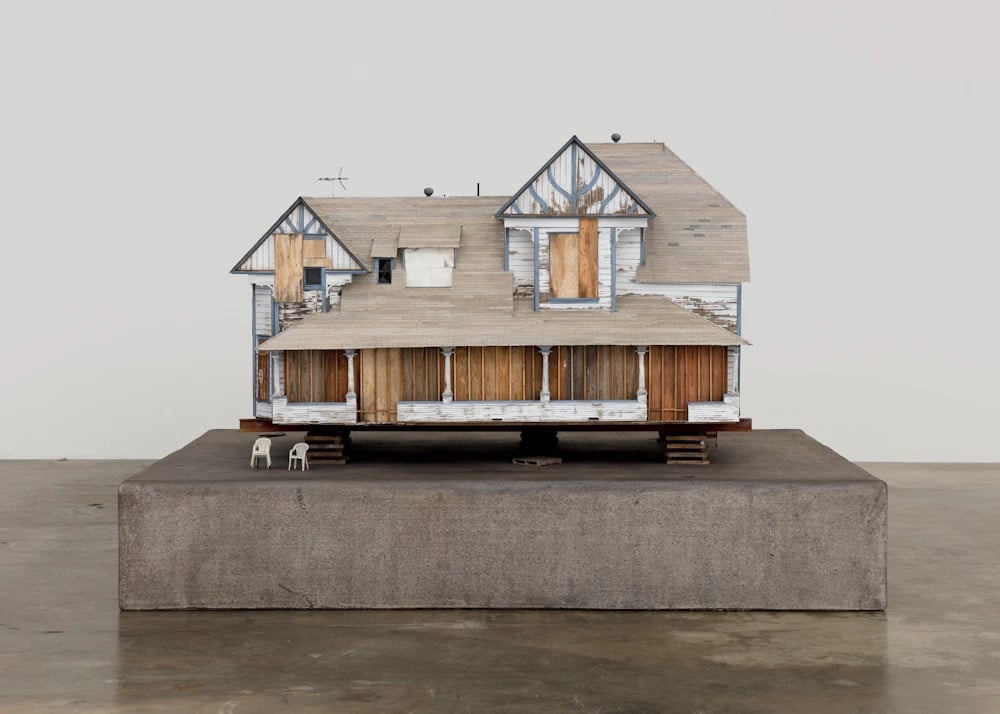
Sayre Gomez, Scale Replica of the Past, Present, and Future (Peabody Werden House) (2023). Courtesy of the artist and Xavier Hufkens.
Fairly recently, though maybe in the past year and a half, I was driving on Soto, one of the main thoroughfares in my studio neighborhood, and I noticed one of the houses was still there—one that I had taken photos of more than a decade ago, back in 2008 or 2009. But, I could have sworn the house had been on the other side of the street. I did a little research and there were news articles about it—the house had been on the other side of the street! The house had been raised and was going to be demolished but a grassroots historical preservation stepped in and got this place protected.
Since 2016, the house has just been sitting there—hovering in limbo—it’s massive and there are condos across the street. It speaks volumes about how we allocate importance within our culture and it’s not something to be remiss about when a hundred thousand homeless people are living on the streets. This house, once it’s lifted, is no longer a house, it’s not functional. It becomes an artwork. To me, the real artwork is driving by that house.





